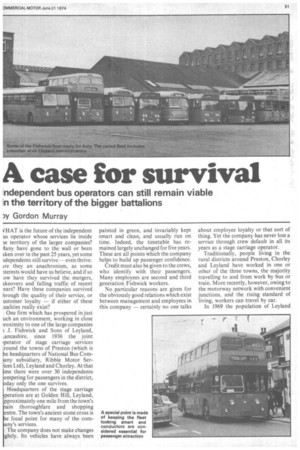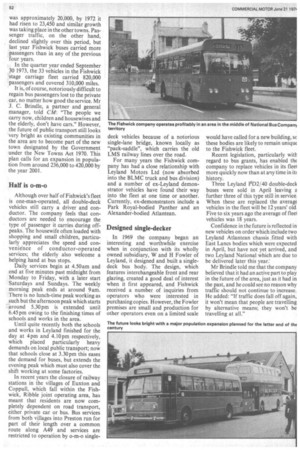A case for survival
Page 53

Page 54

If you've noticed an error in this article please click here to report it so we can fix it.
ndependent bus operators can still remain viable in the territory of the bigger battalions
)y Gordon Murray
VHAT is the future of the independent us operator whose services lie inside territory of the larger companies? 4any have gone to the wall or been 'ken over in the past 25 years, yet some idependents still survive even thrive. kre they an anachronism, as some rterests would have us believe, and if so ow have they survived the mergers, lkeovers and falling traffic of recent ears? Have these companies survived hrough the quality of their service, or ustomer loyalty — if either of these [ualities really exist?
One firm which has prospered in just uch an environment, working in close Iroximity to one of the large companies ; J. Fishwick and Sons of Leyland, ..ancashire. since 1936 the joint rperator of stage carriage services round the towns of Preston (which is e headquarters of National Bus Cornany subsidiary, Ribble Motor Serices Ltd), Leyland and Cho rley. At that me there were over 30 independents ompeting for passengers in the district, day only the one survives.
Headquarters of the stage carriage peration are at Golden Hill, Leyland, pproximately one mile from the town's am n thoroughfare and shopping entre. The town's ancient stone cross is e focal point for many of the cornany's services.
The company does not make changes ghtly. Its vehicles have always been painted in green, and invariably kept smart and clean, and usually run on time. Indeed, the timetable has remained largely unchanged for five years. These are all points which the company helps to build up passenger confidence.
Credit must also be given to the crews, who identify with their passengers. Many employees are second and third generation Fishwick workers.
No particular reasons are given for the obviously good relations which exist between management and employees in this company — certainly no one talks about employee loyalty or that sort of thing. Yet the company has never lost a service through crew default in all its years as a stage carriage operator. Traditionally, people living in the rural districts around Preston, Chorley and Leyland have worked in one or other of the three towns, the majority travelling to and from work by bus or train. More recently, however, owing to the motorway network with convenient junctions, and the rising standard of living, workers can travel by car.
In 1969 the population of Leyland was approximately 20,000, by 1972 it had risen to 23,450 and similar growth was taking place in the other towns. Passenger traffic, on the other hand, declined slightly over this period, but last year Fishwick buses carried more passengers than in any of the previous four years.
In the quarter year ended September 30 1973, the 33 vehicles in the Fishwick stage carriage fleet carried 820,000 passengers and covered 310,000 miles.
It is, of course, notoriously difficult to regain bus passengers lost to the private car, no matter how good the service. Mr J. C. Brindle, a partner and general manager, told CM: "The people we carry now, children and housewives and the elderly, don't have cars." However, the future of public transport still looks very bright as existing communities in the area are to become part of the new town designated by the Government under the New Towns Act 1970. This plan calls for an expansion in population from around 236,000 to 420,000 by the year 2001.
Half is o-m-o
Although over half of Fishwick's fleet is one-man-operated, all double-deck vehicles still carry a driver and conductor. The company feels that conductors are needed to encourage the type of passenger it carries during offpeaks. The housewife often loaded with shopping and small children, particularly appreciates the speed and convenience of conductor-operated services; the elderly also welcome a helping hand at bus stops.
Daily services begin at 4.50 am and end at five minutes past midnight from Monday to Friday, with a later start Saturdays and Sundays. The weekly morning peak ends at around 9am. There is no lunch-time peak working as such but the afternoon peak which starts around 5.30pm is extended until 6.45 pm owing to the finishing times of schools and works in the area.
Until quite recently both the schools and works in Leyland finished for the day at 4 pm and 4.10 pm respectively, which placed particularly heavy demands on local public transport; now that schools close at 3.30pm this eases the demand for buses, but extends the evening peak which must also cover the shift working at some factories.
In recent years the closure of railway stations in the villages of Euxton and Coppull, which fall within the Fishwick, Ribble joint operating area, has meant that residents are now completely dependent on road transport, either private car or bus. Bus services from both villages into Preston run for part of their length over a common route along A49 and services are restricted to operation by o-m-o single deck vehicles because of a notorious single-lane bridge, known locally as "pack-saddle", which carries the old LMS railway lines over the road.
For many years the Fishwick company has had a close relationship with Leyland Motors Ltd (now absorbed into the BLMC truck and bus division) and a number of ex-Leyland demonstrator vehicles have found their way into the fleet at one time or another. Currently, ex-demonstrators include a Park Royal-bodied Panther and an Alexander-bodied Atlantean.
Designed single-decker
In 1969 the company began an interesting and worthwhile exercise when in conjunction with its wholly owned subsidiary, W and H Fowler of Leyland, it designed and built a singledeck bus body. The design, which features interchangeable front and rear glazing, created a good deal of interest when it first appeared, and Fishwick received a number of inquiries from operators who were interested in purchasing copies. However, the Fowler premises are small and production for other operators even on a limited scale would have called for a new building, sc these bodies are likely to remain unique to the Fishwick fleet.
Recent legislation, particularly will' regard to bus grants, has enabled the company to replace vehicles in its fleet more quickly now than at any time in it history. Three Leyland PD2/ 40 double-deck buses were sold in April leaving a further three of this type still in service When these are replaced the average vehicles in the fleet will be 12 years' old Five to six years ago the average of fleet vehicles was 18 years.
Confidence in the future is reflected in new vehicles on order which include two Leyland Atlantean chassis fitted with East Lanes bodies which were expected in April, but have not yet arrived, and two Leyland National which are due to be delivered later this year: Mr Brindle told me that the company believed that it had an active part to play in the future of the area, just as it had in the past, and he could see no reason why traffic should not continue to increase. He added: "If traffic does fall off again, it won't mean that people are travelling by alternative means; they won't be travelling at all."








































































































